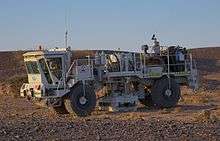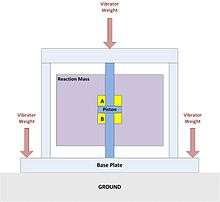Seismic vibrator
A seismic vibrator is a truck-mounted or buggy-mounted device that is capable of injecting low-frequency vibrations into the earth. It is one of a number of seismic sources used in reflection seismology.[1] The ‘Vibroseis’ exploration technique (performed with vibrators) was developed by the Continental Oil Company (Conoco) during the 1950s and was a trademark until the company's patent lapsed.[2]



Today, seismic vibrators are used to perform about half of all seismic surveys on land.[3]
The largest seismic vibration truck in the world, known as 'Nomad 90’, weighs 41.5T and has a 90,000 lbf force.
Principle
A seismic vibrator transforms the energy provided by a diesel engine into a vibration. It is performed by a shaker, a movable element that generates the vibration thanks to a piston-reaction mass device driven by an electrohydraulic servo valve. The shaker is applied to the ground for each vibration, then raised up so that the seismic vibrator can move to another vibrating point.[4]
Vibrator capability is defined by the maximum force it is capable to generate, called High Peak Force and measured in pound-force. To transmit a maximum force to the ground and prevent the shaker from bumping, part of the weight of the vibrator is applied to the shaker.
Popular culture
The plot of Ken Follett's 1998 thriller The Hammer of Eden turns on the use of a stolen seismic vibrator truck by ecoterrorists.
References
- Robert E. Sheriff, Encyclopedic Dictionary of Applied Geophysics (Geophysical References No. 13) 4th Edition, 2002, 429 pag. ISBN 978-1560801184.
- Anstey, Nigel A., Vibroseis, Prentice Hall, 1991.
- Guido Baeten; Anton Ziolkowski (1990). The Vibroseis Source. Elsevier. ISBN 978-0-444-88879-2.
- Li d th R O Lindseth, Roy O., Di it l P i f G h i l D t Digital Processing of Geophysical Data— A Review, originally published 1968, SEG Course Notes, 1982, 282 pages, Catalog #251A
External links
| Wikimedia Commons has media related to Thumper trucks. |
- Seismic Research at the KGS, description of seismic vibrator and how the Kansas Geological Survey uses it
- Alaska Department of Fish and Game, image of a vibroseis in use
- Geosys IVI Pictures and descriptions of seismic vibrators manufactured by Geosys, Inc. of Japan
- Vibrator truck Images of a vibrator trucks used by the University of Calgary